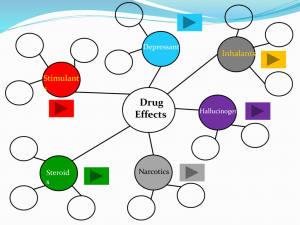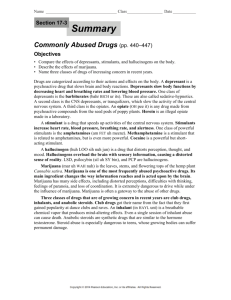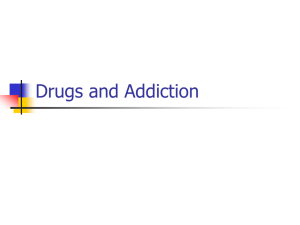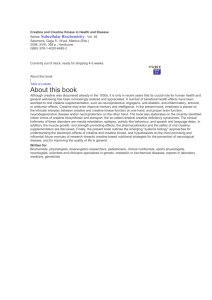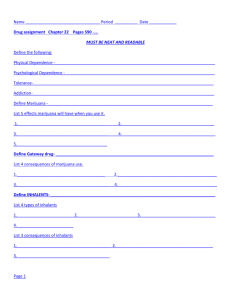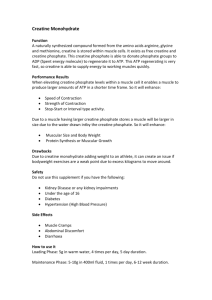Performance Enhancing Drugs Androstenedione What is it?
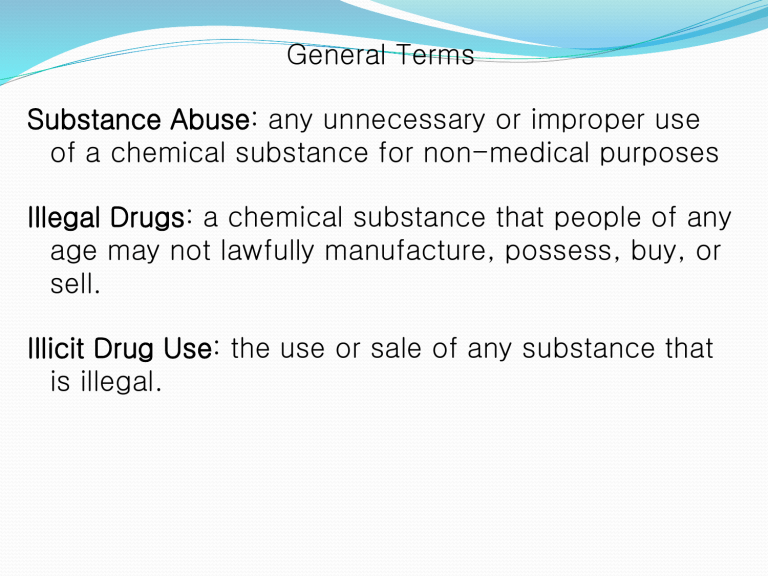
General Terms
Substance Abuse: any unnecessary or improper use of a chemical substance for non-medical purposes
Illegal Drugs: a chemical substance that people of any age may not lawfully manufacture, possess, buy, or sell.
Illicit Drug Use: the use or sale of any substance that is illegal.
Overdose: a strong or sometimes fatal reaction to taking a drug.
Addiction: a physiological or psychological dependence on a drug.
Tolerance: a condition in which the body becomes accustomed to the drug and causes the user to experience a need for more of the drug to achieve the desired effect.
Psychological Dependence: a condition that develops over time and causes a person to believe that a drug is needed to function normally.
Physiological Dependence: a condition in which the user develops a chemical need for a drug.
Symptoms of withdrawal occur when the effects of the drug wear off.
Psychoactive Drugs
Chemicals that affect the central nervous system.
Narcotics, Stimulants, Depressants, and
Hallucinogens.
Narcotics, Stimulants, Depressants have medical value while hallucinogens do not .
Psychoactive Drugs
Stimulants speed up the body
Narcotics relieve pain
Depressants slow down the body
Hallucinogen alter perception (time, sight, touch, smell…)
Hallucinogens
LSD: First synthesized LSD in 1938.
LSD is sold as tablets, capsules, and occasionally in liquid form
Is often added to absorbent paper and divided into small decorated squares
Hallucinogens (LSD
)
Schedule I
Street names: Acid, micro-dots,
Effects: alters personality, mood, and expectations. Lasts up to 12 hours. LSD users often have flashbacks. In addition, LSD users may develop long-lasting psychoses, such as schizophrenia or severe depression
Pictures
Hallucinogens
PCP (Phencyclidine)
Street names: PCP, Angel Dust, Supergrass, Killer
Weed.
PCP is most commonly sold as a powder or liquid.
Hallucinogens
PCP (Phencyclidine)
PCP may be snorted, smoked, injected, or swallowed
Numbness, slurred speech, loss of coordination, rapid and involuntary eye movements
Auditory hallucinations, image distortion, severe mood disorders, amnesia,
PCP use is associated with a number of risks and many believe it to be one of the most dangerous drugs of abuse
Heroin
Illegal & highly addictive drug. It is both the most abused and the most rapidly acting of the opiates.
Heroin is processed from morphine. Heroin can be injected, smoked, or sniffed/snorted
Schedule: I
Street names: Smack, thunder, hell dust, big H, nose drops
Harmful effects: collapsed veins, infection of the heart lining and valves, abscesses, cellulites, and liver disease
Pictures
Predatory Drugs
Drugs used to take advantage of someone.
(Rape in most cases)
GHB (gamma hydroxybutyric acid)
Rohypnol
Predatory Drugs
GHB (gamma hydroxybutyric acid)
Street Names: Liquid Ecstasy,
Scoop, Georgia Home Boy, Liquid
X.
An odorless, colorless liquid form
GHB
Usually ingested in a liquid mixture; most commonly mixed with alcohol
GHB has become popular among teens and young adults at dance clubs and "raves."
Body builders sometimes use GHB for its alleged anabolic effects
GHB
In lower doses, GHB causes drowsiness, dizziness, nausea, and visual disturbances.
At higher dosages, unconsciousness, seizures, severe respiratory depression, and coma can occur.
Rohypnol
Street Names : Mexican Valium, roophies.
Rohypnol is usually taken orally in pill form, but can also be crushed and snorted
Rohypnol continues to be abused among teenagers and young adults, usually at raves and nightclubs.
Rohypnol
One of the significant
effects
of the drug is drug amnesia, a factor that strongly contributed to its inclusion in the Drug-Induced Rape
Prevention and Punishment Act of
1996. Amnesia is a condition in which events that occurred while under the influence of the drug are forgotten
.
Cocaine
Cocaine
is a powerfully addictive stimulant. Cocaine is one of the oldest known drugs.
Street names: Blow, nose candy, snowball.
Harmful effects: Increased heart rate, irritability, restlessness, and paranoia
Pictures
Methamphetamines
A highly addictive drug with potent central nervous system stimulant properties
The drug has limited medical uses for the treatment of narcolepsy, attention deficit disorders, and obesity.
Schedule II
Methamphetamines
Street Names
: Speed, Meth, Ice,
Crystal.
Effects
: As a powerful stimulant, methamphetamine, even in small doses, can increase wakefulness and physical activity and decrease appetite.
Methamphetamines
Abusers exhibit symptoms that can include violent behavior, anxiety, confusion, and insomnia. They also can display a number of psychotic features, including paranoia, auditory hallucinations, mood disturbances, and delusions (for example, the sensation of insects creeping on the skin, which is called “formication”). The paranoia can result in homicidal as well as suicidal thoughts.
Marijuana
Marijuana is the most commonly abused illicit drug in the United States. A dry, shredded green/brown mix of flowers, stems, seeds, and leaves of the plant Cannabis sativa, it usually is smoked as a cigarette (joint, nail), or in a pipe (bong). It also is smoked in blunts, which are cigars that have been emptied of tobacco and refilled with marijuana, often in combination with another drug. It might also be mixed in food or brewed as a tea
Street names : Grass, pot, weed, bud, Mary
Jane, dope.
Marijuana
Within a few minutes after inhaling marijuana smoke, an individual’s heart begins beating more rapidly
As THC enters the brain, it causes a user to feel euphoric— or “high”—by acting in the brain’s reward system
A marijuana user may experience pleasant sensations, colors and sounds may seem more intense, and time appears to pass very slowly
Marijuana
Occasionally, marijuana use produces anxiety, fear, distrust, or panic.
Someone who smokes marijuana regularly may have many of the same respiratory problems that tobacco smokers do, such as daily cough and phlegm production, more frequent acute chest illnesses, a heightened risk of lung infections
Pictures
Marijuana
Cancer of the respiratory tract and lungs may also be promoted by marijuana smoke. Marijuana smoke contains 50 percent to 70 percent more carcinogenic hydrocarbons than does tobacco smoke
Marijuana's damage to short-term memory seems to occur because THC alters the way in which information is processed by the hippocampus, a brain area responsible for memory formation.
MDMA (Ecstasy)
MDMD is a synthetic, psychoactive drug chemically similar to the stimulant methamphetamine and the hallucinogen mescaline. MDMA is an illegal drug that acts as both a stimulant and hallucinogen, producing an energizing effect, as well as distortions in time and perception and enhanced enjoyment from tactile (touch) experiences.
MDMA (Ecstasy)
Street Names: Ecstasy, XTC, E, X
Schedule I
MDMA can interfere with the body’s ability to regulate temperature. This can lead to a sharp increase in body temperature (hyperthermia), resulting in liver, kidney, and cardiovascular system failure, and death
MDMA (Ecstasy)
Long term effects: Brain damage, as well as impaired thought, judgment and mood.
Pictures
Inhalants
•Inhalants are a diverse group of substances that include volatile solvents, gases, and nitrites that are sniffed, snorted, huffed, or bagged to produce intoxicating effects similar to alcohol.
•These substances are found in common household products like glues, lighter fluid, cleaning fluids, and paint products
Inhalants
•Affects: Use of inhalants has been associated with serious health problems. Sniffing glue and paint thinner causes kidney abnormalities, while sniffing the solvents toluene and trichloroethylene cause liver damage. Memory impairment, attention deficits, and diminished non-verbal intelligence have been related to the abuse of inhalants. Deaths resulting from heart failure, asphyxiation, or aspiration have occurred.
Inhalants
•Most inhalants act directly on the central nervous system (CNS) to produce psychoactive, or mindaltering, effects. They have short-term effects similar to anesthetics, which slow the body's functions
•Alcohol-like effects may include slurred speech, an inability to coordinate movements, euphoria, and dizziness. In addition, users may experience lightheadedness, hallucinations, and delusions.
Performance Enhancing Drugs
Androstenedione
What is it?
Androstenedione (andro) is a hormone produced by the adrenal glands, ovaries and testes. It's a hormone that's normally converted to testosterone and in both men and women.
Andro is available in prescription and nonprescription forms. The prescription version is a controlled substance.
Andro is also sold without a prescription as a nutritional supplement. Manufacturers and bodybuilding magazines tout its ability to allow athletes to train harder and recover more quickly. However, its use as a performance-enhancing drug is illegal in the United States.
Performance Enhancing Drugs
Androstenedione
Risks
Side effects of andro in men include:
Acne
Diminished sperm production
Shrinking of the testicles
Enlargement of the breasts
In women, side effects include:
Acne
Masculinization, such as deepening of the voice and male-pattern baldness
In both men and women, andro can decrease HDL cholesterol (the
"good" cholesterol), which puts you at greater risk of heart attack and stroke.
Performance Enhancing Drugs
Human growth hormone
What is it?
Human growth hormone, also known as gonadotropin, is a hormone that has an anabolic effect. Athletes take it to improve muscle mass and performance. However, it hasn't been shown conclusively to improve either strength or endurance. It is available only by prescription and is administered
Performance Enhancing Drugs
Human growth hormone
Risks
Adverse effects related to human growth hormone range in severity and may include:
Joint pain
Muscle weakness
Fluid retention
Carpal tunnel syndrome
Impaired glucose regulation
Cardiomyopathy
Hyperlipidemia
Performance Enhancing Drugs
Erythropoietin
What is it?
Erythropoietin is a type of hormone used to treat anemia in people with severe kidney disease. It increases production of red blood cells and hemoglobin, resulting in improved movement of oxygen to the muscles. Epoetin, a synthetic form of erythropoietin, is commonly used by endurance athletes.
Risks
Erythropoietin use among competitive cyclists was common in the 1990s and allegedly contributed to at least
18 deaths. Inappropriate use of erythropoietin may increase the risk of thrombotic events, such as stroke, heart attack and pulmonary edema.
Performance Enhancing Drugs
Stimulants
What are they?
Some athletes use stimulants to stimulate the central nervous system and increase heart rate and blood pressure.
Stimulants can:
Improve endurance
Reduce fatigue
Suppress appetite
Increase alertness and aggressiveness
Common stimulants include caffeine and amphetamines. Cold remedies often contain the stimulants ephedrine or pseudoephedrine hydrochloride. The street drugs cocaine and methamphetamine also are stimulants
Performance Enhancing Drugs
Stimulants
Risks
Although stimulants can boost physical performance and promote aggressiveness on the field, they have side effects that can impair athletic performance.
Nervousness and irritability make it hard to concentrate on the game.
Insomnia can prevent an athlete from getting needed sleep.
Dehydration
Heatstroke
Athletes may become psychologically addicted or develop a tolerance so that they need greater amounts to achieve the desired effect, meaning they'll take doses that are much higher than the intended medical dose.
Performance Enhancing Drugs
Stimulants
Risks
Other side effects include:
Heart palpitations
Heart rhythm abnormalities
Weight loss
Tremors
Mild hypertension
Hallucinations
Convulsions
Stroke
Heart attack and other circulatory problems
Performance Enhancing Drugs
Creatine
What is it?
Many athletes take nutritional supplements instead of or in addition to performance-enhancing drugs. Supplements are available over-the-counter as powders or pills.
The most popular supplement among athletes is probably creatine monohydrate. Creatine is a naturally occurring compound produced by your body that helps your muscles release energy.
Performance Enhancing Drugs
Creatine
Scientific research indicates that creatine may have some athletic benefit by producing small gains in short-term bursts of power.
There's no evidence, however, that creatine enhances performance in aerobic or endurance sports
Your liver produces about 0.07 ounces (2 grams) of creatine each day. You also get creatine from the meat in your diet.
Creatine is stored in your muscles, and levels are relatively easily maintained. Because your kidneys remove excess creatine, the value of supplements to someone who already has adequate muscle creatine content is questionable.
Performance Enhancing Drugs
Creatine
Risks
Supplements are considered food and not drugs by the FDA. This means supplement manufacturers are not required to conform to the same standards as drug manufacturers do. In some cases, supplements have been found to be contaminated with other substances, which may inadvertently lead to a positive test for performance-enhancing drugs.
Possible side effects of creatine that can decrease athletic performance include:
Stomach cramps
Muscle cramps
Nausea
Diarrhea
Weight gain
Performance Enhancing Drugs
Creatine
Weight gain is sought after by athletes who want to increase their size.
But with prolonged creatine use, weight gain is more likely the result of water retention than an increase in muscle mass. Water is drawn into your muscle tissue, away from other parts of your body. This puts you at risk of dehydration.
High-dose creatine use may potentially damage your:
Kidneys
Liver
It appears safe for adults to use creatine at the doses recommended by manufacturers. But it's unknown what kind of effect taking creatine has over the long term, especially in teens and children.
Performance Enhancing Drugs
Anabolic steroids
What are they?
Some athletes take a form of steroids — known as anabolic-androgen steroids or just anabolic steroids — to increase their muscle mass and strength. The main anabolic steroid hormone produced by your body is testosterone.
Testosterone has two main effects on your body:
Anabolic effects promote muscle building.
Androgenic effects are responsible for male traits, such as facial hair and a deeper voice.
Performance Enhancing Drugs
Anabolic steroids
Anabolic steroids come with serious physical side effects as well.
Men may develop :
Prominent breasts
Baldness
Shrunken testicles
Infertility
Women may develop :
A deeper voice
An enlarged clitoris
Increased body hair
Baldness
Performance Enhancing Drugs
Anabolic steroids
Both men and women might experience:
Severe acne
Increased risk of tendinitis and tendon rupture
Liver abnormalities and tumors
Increased low-density lipoprotein (LDL) cholesterol (the "bad" cholesterol)
Decreased high-density lipoprotein (HDL) cholesterol (the "good" cholesterol)
Hypertension
Heart and circulatory problems
Aggressive behaviors, rage or violence
Psychiatric disorders, such as depression
Infections or diseases such as HIV or hepatitis if you're injecting the drugs
Inhibited growth and development, and risk of future health problems in teenagers
